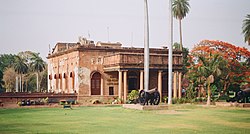| British Residency | |
|---|---|
 | |
 | |
| General information | |
| Location | Lucknow, Uttar Pradesh |
| Coordinates | 26°51′42″N80°55′33″E / 26.8618°N 80.9257°E |
| Groundbreaking | 1780 |
| Completed | 1800 |

The Residency, also called as the British Residency and Residency Complex, is a group of several buildings in a common precinct in the city of Lucknow, Uttar Pradesh, India. It served as the residence for the British Resident General who was a representative in the court of the Nawab of Awadh or Oudh. The Residency of Lucknow, one of the Residencies of British India, is located in the heart of the city, in the vicinity of other monuments like Shaheed Smarak, Tehri Kothi and the High Court Building.


